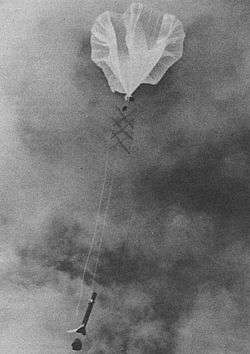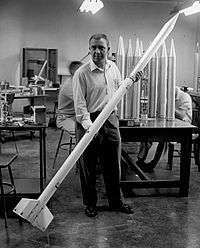Rockoon

A rockoon (from rocket and balloon) is a solid fuel sounding rocket that, rather than being immediately lit while on the ground, is first carried into the upper atmosphere by a gas-filled balloon, then separated from the balloon and ignited. This allows the rocket to achieve a higher altitude, as the rocket does not have to move under power through the lower and thicker layers of the atmosphere.
The original concept was developed by Cmdr. Lee Lewis, Cmdr. G. Halvorson, S. F. Singer, and James A. Van Allen during the Aerobee rocket firing cruise of the U.S.S. Norton Sound on March 1, 1949.
A serious disadvantage is that balloons cannot be steered and consequently neither the direction the launched rocket moves in nor the region where it will fall is easily adjustable. Therefore, a large area for the fall of the rocket is required for safety reasons.
Early atmospheric research
TIME magazine reported in 1959: "Van Allen's 'Rockoons' could not be fired in Iowa for fear that the spent rockets would strike an Iowan or his house." So Van Allen convinced the U.S. Coast Guard to let him fire his rockoons from the icebreaker Eastwind that was bound for Greenland. "The first balloon rose properly to 70,000 ft., but the rocket hanging under it did not fire. The second Rockoon behaved in the same maddening way. On the theory that extreme cold at high altitude might have stopped the clockwork supposed to ignite the rockets, Van Allen heated cans of orange juice, snuggled them into the third Rockoon's gondola, and wrapped the whole business in insulation. The rocket fired."

The Office of Naval Research (USA ONR) used the Loki in some of its Rockoon launches, lofting the Loki to high altitudes on a helium balloon before firing, for upper atmosphere research.[1] The first Rockoon launch of the Loki I occurred on Jul 1 1955 from shipboard off the coast of Greenland.[2]
During Jul-Oct 1955 instrumented Loki I and Deacon rockets were successfully balloon launched (Rockoons) from shipboard off the coast of Greenland in cosmic-ray studies by The University of Iowa research group. Army Ordnance supplied JPL-developed Loki rockets and ONR sponsored the project.[3]
The first attempt of the Deacon Rockoon on Aug 21 1952 06:25 GMT from the Arctic Ocean 80.1 N x 68.5 W was a failure.[4] However, success came on Aug 9 1953 in the Atlantic Ocean, Launch Site 11 Launch Point 10 74.38 N x 71.93 W, at 05:54 GMT.[5] Quickly followed by another success on Aug 30 1953 20:46 GMT at Atlantic Ocean Launch Site 11 Launch Point 13 53.13 N, 54.75 W.[5]
In September 1957, as part of the U.S. contributions for the International Geophysical Year, Thirty-six Rockoons (balloon-launched rockets) were launched from Navy icebreaker U.S.S. Glacier in Atlantic, Pacific, and Antarctic areas ranging from 75° N. to 72° S. latitude, as part of the scientific program headed by James A. Van Allen and Lawrence J. Cahill of The University of Iowa. These were the first known upper atmosphere rocket soundings in the Antarctic area. Launched from IGY Rockoon Launch Site 2, Atlantic Ocean; Latitude: 0.83° N, Longitude: 0.99° W.
Recent usage
More recently, the JP Aerospace company has developed and used rockoons as part of its space access plans.[6] Additionally, Iowa State University and Purdue University have started programs to develop rockoons[7][8] and significant work has been recently done by the Romanian space company ARCASPACE. The Spanish company zero2infinity plan to launch a toroid shaped rocket from a balloon called Bloostar in 2018 to carry micro satellites to low earth orbit.
See also
| Look up rockoon in Wiktionary, the free dictionary. |
- JP Aerospace
- CU Spaceflight
- Da Vinci Project
- Air launch to orbit
- Non-rocket spacelaunch
- Zero2infinity's Bloostar
References
- ↑ "Chronology - Quarter 2 1951". Archived from the original on January 18, 2010.
- ↑ "Chronology - Quarter 3 1955". Archived from the original on December 2, 2008.
- ↑ "Aeronautics and Astronautics Chronology, 1955-57".
- ↑ "Chronology - Quarter 3 1952". Archived from the original on January 18, 2010.
- 1 2 "Chronology - Quarter 3 1953". Archived from the original on December 2, 2008.
- ↑ http://www.jpaerospace.com/rockoons.html. Retrieved 27 Feb 2010
- ↑ http://wiki.seds.org/index.php/ISU_Rockoon_Project. Retrieved 27 Feb 2010
- ↑ http://www.purdueorbital.com. Retrieved 01 Sep 2016
- "Encyclopedia Astronautica - Rockoon".
- Leland Goodwin, Harold (1963). The Flying Stingaree. Rick Brant Science-Adventure Series.
External links
| Look up rockoon in Wiktionary, the free dictionary. |
- Details of Rockoon launches made in 1956 from the USS COLONIAL in the Pacific Ocean Stratocat website
- Details of Rockoon launches made between 1952 and 1954 in the Arctic by the USCGC EASTWIND Stratocat website
- High Altitude Research Corporation